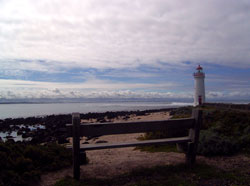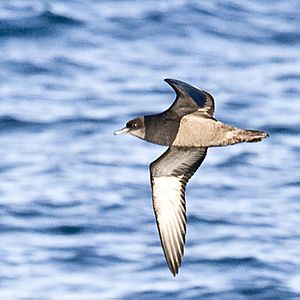Griffiths Island facts for kids

The original mouth of the Moyne River, with the western end of Griffiths Island behind
|
|
| Etymology | Jonathan Griffiths |
|---|---|
| Geography | |
| Location | Western District, Victoria |
| Coordinates | 38°23′36″S 142°14′45″E / 38.39333°S 142.24583°E |
| Adjacent bodies of water | Bass Strait, Southern Ocean |
| Total islands | 3 |
| Major islands | Griffiths Island |
| Area | 31 ha (77 acres) |
| Length | 1.5 km (0.93 mi) |
| Width | 0.8 km (0.5 mi) |
| Administration | |
|
Australia
|
|
Griffiths Island is a small island located at the mouth of the Moyne River. It sits right next to the town of Port Fairy in the Western District of Victoria, Australia.
Today, no one lives permanently on Griffiths Island. However, a special road called a causeway connects it to the mainland, so people can easily walk there. The island is part of the Port Fairy and Belfast Coastline Protection Reserve. It's a popular spot for tourists and also holds important history about how Europeans first settled western Victoria. The local government, called the Moyne Shire Council, looks after the island.
Contents
Island History
 |
|
| Location | Port Fairy Victoria< Australia |
|---|---|
| Coordinates | 38°23′06″S 142°15′04″E / 38.38500°S 142.25111°E |
| Year first lit | 1859 |
| Construction | bluestone tower |
| Tower shape | cylindrical tower with balcony and lantern |
| Markings / pattern | white tower with red trim and lantern |
| Height | 11 metres (36 feet) |
| Focal height | 12.5 metres (41 feet) |
| Original lens | catadioptric lantern |
| Range | 22 kilometres (14 miles) |
| Characteristic | Fl (2) W 10 s. |
| Admiralty number | K2146 |
| NGA number | 8028 |
| ARLHS number | AUS-086 |
Not much evidence remains of the Aboriginal people using Griffiths Island. However, the local Gunditjmara people, who called the island Moleen, did visit it.
The island was later named after John Griffiths. He was a businessman and merchant from Launceston, Tasmania. He played a big part in the early history of this area.
From the mid-1830s until 1843, Griffiths Island was a base for whaling. Whalers hunted southern right whales from the bay. This industry stopped when there were no more whales left to catch. Some shipbuilding also happened on the island in the 1840s.
After the whaling station closed, its buildings were used by Flora Dunlop until 1854. She was the widow of a politician named Alexander Dunlop. She used the buildings to help young Indigenous Australians.
Because of its important history and old remains, Griffiths Island is listed on the Victorian Heritage Register. This means it's a protected historical site.
Griffiths Island Lighthouse
The Griffiths Island Lighthouse was built in 1859. It helped ships find their way when Port Fairy was a busy trading port for western Victoria. Over time, many changes were made to the harbor to make the Moyne River easier for ships to use. These changes also affected the shape of the island.
The lighthouse is now managed by the Victorian Channels Authority, which is part of the Port of Melbourne Corporation. It was built from local bluestone by skilled Scottish stonemasons. The stairs inside were built by fitting each step into the stone wall as it was built.
At first, two people lived on the island to look after the lighthouse. The last lighthouse keeper lived there from 1929 to 1954. After that, the light was automated, meaning it worked by itself. The two stone cottages where the keepers lived were taken down around 1956.
Island Description
Griffiths Island is a low-lying island. It is about 1.5 kilometers (0.9 miles) long and 0.8 kilometers (0.5 miles) wide at its widest point. Its total area is about 31 hectares (77 acres).
The Moyne River runs along the northern side of the island. The river has been channeled between stone 'training walls'. These walls make it easy for boats to reach Port Fairy from the sea.
Originally, Griffiths Island was actually three separate islands: Goat, Rabbit, and Griffiths. But over time, harbor work and natural processes have joined them into one single island. This island now protects the mouth of the Moyne River and shelters Port Fairy Bay.
Island Geology
Griffiths Island is made up of basalt rocks and boulders. These sit on top of older limestone from the early Pleistocene period. On top of that, there is calcareous sand.
The island was formed by lava flows from Mount Rouse. This volcano is near Penshurst. The lava reached the coast about 300,000 to 400,000 years ago. Parts of the island are bordered by collapsed lava tunnels. For example, the causeway connecting the island to the mainland was built across one of these tunnels.
Newer limestone, about 100,000 years old, can be found on the southern coast. Some parts of the island are covered by Holocene dunes, which are about 6,000 years old.
Island Flora
Griffiths Island is located in the Warrnambool Plain Bioregion. The plants that originally grew here would have been similar to nearby areas. This included coastal shrubland, grassland, and woodland. However, human activities on the island have changed the plant life a lot.
Some of the main native plants you can find include:
- Bower spinach
- Small leaved clematis
- Seaberry saltbush
- Coast beard-heath
- Cushion bush
- Karkalla
- Common boobialla
- Knobby club-sedge
- Coast spear-grass
- Coast sword-sedge
- Kangaroo apple
- Coast daisy bush
- Coast tussock-grass
- Hairy spinifex
- Bidgee-widgee
In the past, marram grass was planted widely to help stop the soil from washing away.
Island Fauna and Reproduction
About 80 to 90 different kinds of birds have been seen on Griffiths Island. Many of these are seabirds and waders (birds that walk in shallow water).
The island is home to a very large breeding colony of short-tailed shearwaters. These birds are also known as 'muttonbirds'. Experts estimate there are about 100,000 burrows on the island. Less than half of these burrows are used during the breeding season, which runs from September to April.
The shearwater colony is a big attraction for tourists in spring and summer. There's a special viewing platform where you can watch the birds. They return in a huge group to their burrows at dusk, which is an amazing sight!
Other animals that live on the island include swamp wallabies, short-beaked echidnas, blue-tongued lizards, and tiger snakes.



